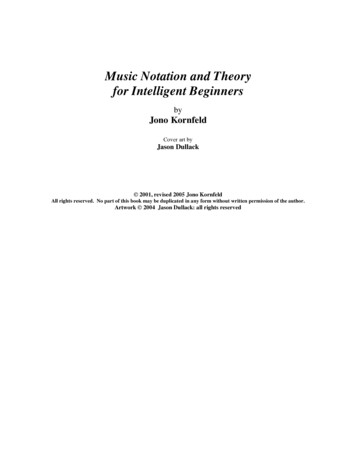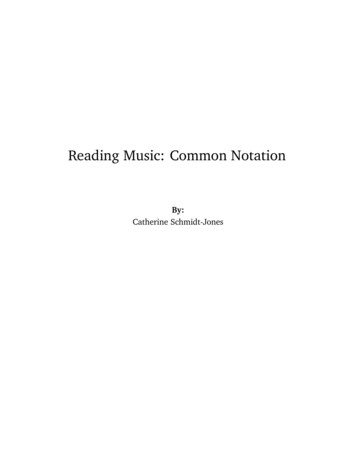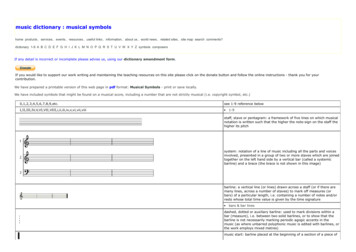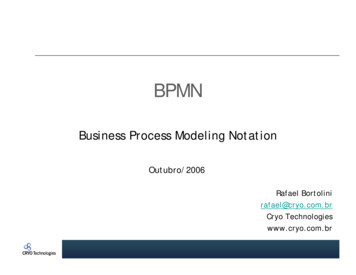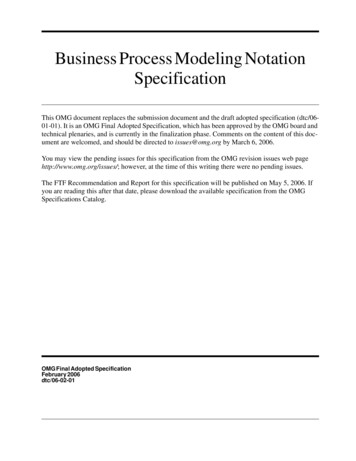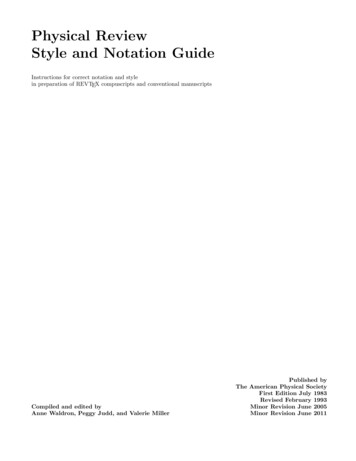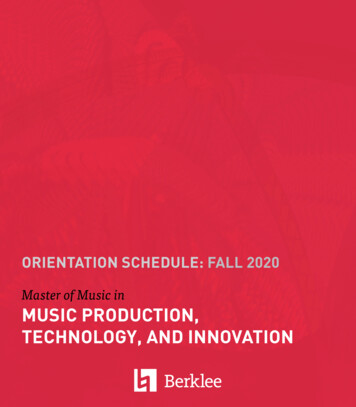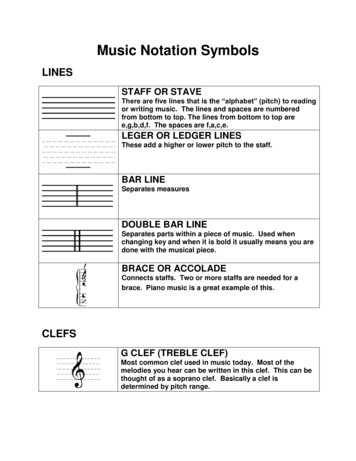
Transcription
Music Notation SymbolsLINESSTAFF OR STAVEThere are five lines that is the “alphabet” (pitch) to readingor writing music. The lines and spaces are numberedfrom bottom to top. The lines from bottom to top aree,g,b,d,f. The spaces are f,a,c,e.LEGER OR LEDGER LINESThese add a higher or lower pitch to the staff.BAR LINESeparates measuresDOUBLE BAR LINESeparates parts within a piece of music. Used whenchanging key and when it is bold it usually means you aredone with the musical piece.BRACE OR ACCOLADEConnects staffs. Two or more staffs are needed for abrace. Piano music is a great example of this.CLEFSG CLEF (TREBLE CLEF)Most common clef used in music today. Most of themelodies you hear can be written in this clef. This can bethought of as a soprano clef. Basically a clef isdetermined by pitch range.
C CLEF (ALTO OR TENOR CLEF)This clef can be thought of as an alto or tenor clef. It canbe movable. Middle c is determined where the middle ofthe picture is pointing to. In this case it is the third lineand for that reason it is an alto clef. If it were pointing tothe fourth line it would be a tenor clef. This clef is mostlyused for alto or tenor instruments such as a viola, cello,bassoon, etc.F CLEF (BASS CLEF)This and the treble clef are most popular. This is basicallyin the low range of music.NOTE AND RESTSHOLE NOTEThis note gets four beatsWHOLE NOTE RESTRest for four beatsHALF NOTEThis note gets two beats(to get three beats a dot is placed next to a half note)HALF NOTE RESTRest for two beats
QUARTER NOTEThis note gets one beatQUARTER NOTE REST(S)Rest for one beatEIGHTH NOTEThis note get half of the beatEIGHTH NOTE RESTRest for half a beatSIXTEENTH NOTEThis note gets a quarter of the beatSIXTEENTH NOTE RESTRest for a quarter of the beatBEAMED NOTESThe example to the left is an eighth note that isbeamed. Sixteenth notes also can be beamed.DOTTED NOTESA dot adds half the value to the existing note. The halfnote (two beats) plus half the value for the dot (one beat)gives us three beats.
MULTI-MEASURED RESTA bold line with vertical lines at the beginning and endindicates many measured rests. In this case themeasured rest is ten measures.BREAKS, PAUSES, ACCIDENTALS, AND KEYSIGNATURESBREATH MARKA pause in the music—usually in singing but occurs ininstrumental music also.CAESURAA stop in the music (most likely a sudden stop). Thestop is usually brief but can have a great impact if doneright.FLATLowers the pitch of the note a half stepSHARPRaises the pitch of the note a half stepNATURALThis offsets the key signature or previous accidental.DOUBLE FLATLowers the pitch a whole step
DOUBLE SHARPRaises the pitch a whole stepFLAT KEY SIGNATUREA simple explanation is a piece of music that has at leastone flat in it. There can be 7 of these but most music hasabout four. The key signature can be found at thebeginning of the piece or at the beginning of each line ofmusic.SHARP KEY SIGNATUREA simple explanation is a piece of music that has at leastone flat in it.TIME SIGNATURESSPECIFIED TIME SIGNATUREThe top number lets you know how many beats are in thebar. The bottom number specifies the note valuedetermining what gets counted in a bar.COMMON TIMEThe same as 4/4 timeCUT TIMEThis is actually 2/2 time. The top 2 meaning you havetwo beats to the bar with the half note determining whatis counted in the bar.METRONOME MARKThis tells you how fast the note is played. In the exampleto the left, the quarter note 120
NOTE RELATIONSHIPSTIEThe same note is playedSLURTwo or more notes that have no break or breathPORTAMENDO OR GLISSANDOA continuous glide from one note another noteTUPLETThis is an irregular structure in which the notes are to beequal but played in the time allowed.CHORDThe first, third, and fifth of a scale that is played togetherARPEGGIATED CHORDFast succession of the notes instead of hitting all thenotes at the same timeDYNAMICSPIANISSISSIMOA note that is played very very soft (you rarely seeanything that is to played any softer)
PIANISSIMOA note the is played very soft (this is the softest youmost likely see in music)PIANOA note that is played softMEZZO PIANOA note that is played half as soft as pianoMEZZO FORTEA note the is played half as loud as forte (this is thedefault level if no marking is given)FORTEA note that is played loudFORTISSIMOA note that is played very loudFORTISSISSIMOA note that is played very very loudSFORZANDOA note that is played with a sudden or fierce soundFORTE PIANOA section of music that is played loud then suddenly softCRESCENDOA note or group of notes that is played soft and getslouderDECRESCENDO OR DIMINUENDOA note or group of notes that is played loud and getssofterARTICULATION MARKSSTACCATOThis note is to be played short and somewhat “punched”
STACCATISSIMOThis note is to be played short and more “punched” thanstaccatoTENUTOThe line on top means the note is to be played long. Notnecessarily longer than the note value but played outand more prevalent.MARCATOThis is an attack sign and the note or notes should beplayed with that in mindFERMATOThis note is played and held (how long depends on themusician or leader of the group)ORNAMENTSTRILLVery fast playing of the note specified and the next noteaccording to the key signatureMORDENTVery fast playing of the note specified and the next noteaccording the key signature. This is not continuous asin the trill. When you get back to the original note youhold the specified note.TURNThis can be done is many different ways. The main ideais playing the specified note, playing the next note(within the same key signature), returning to thespecified note, playing the next lower note (within thesame key signature), and landing back at the specifiednote.
APPOGGIATURAFirst play the top note than the specified note equally intime valueACCIACCATURAFirst play the top note than the specified note (Yes theappoggiatura and acciaccatura have the same definitionand how do you distinguish the two? You can see theylook exactly the same. Knowing what the composerwanted can only help you.OCTAVESOTTAVA ALTANotes are to be played one octave higher than what isnotedQUINDICESIMA ALTANotes are to be played two octaves higher than what isnotedOTTAVA BASSANotes are to be played an octave lower than what isnotedQUINDICESIMA BASSNotes are to be played two octaves lower than what isnotedREPETITION AND CODAS
TREMOLOA note that is rapidly repeated. In this case the noteactually becomes a thirty-second note because there arethree lines through it.REPEAT SIGNThe passage just played should be played againSIMILE MARKSThese are marks that say you need to repeat a bar ornumber of bars. The first example the left means repeatthe previous bar the second example means repeat theprevious two barsVOLTA BRACKETSThis pertains to endings of a piece of music.DA CAPOGo back to the beginning of the piece and play it againtill you see al fine or the codaDAL SEGNORepeat starting from the nearest segno. Play until yousee al fine or the coda marking.SEGNOWhere you start after seeing the D.S. markingCODATakes you to the end of the piece after playing a D.S. orD.C.I would like to thank Wikipedia for using their symbols. Also, Text of Creative Commonsand Free Documentation License
Music Notation Symbols LINES STAFF OR STAVE There are five lines that is the “alphabet” (pitch) to reading or writing music. The lines and spaces are numbered from bottom to top. The lines from bottom to top are e,g,b,d,f. The spaces are f,a,c,e. LEGER OR LEDGER LINES These add a higher or lower pitch to the staff. BAR LINE Separates measures DOUBLE BAR LINE Separates parts within a piece .
